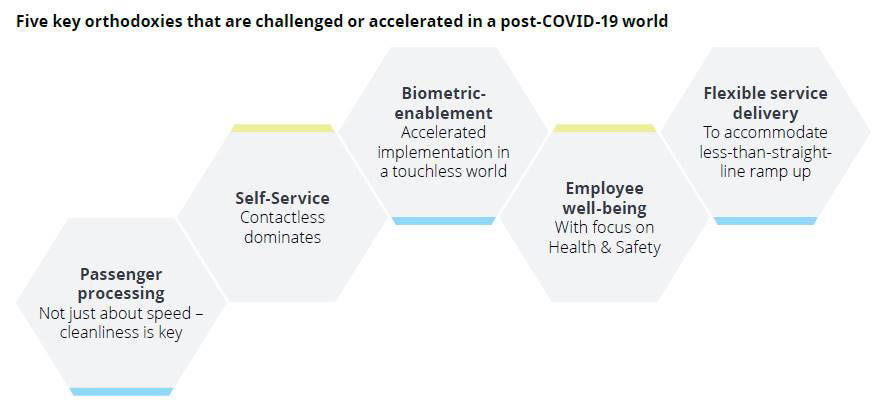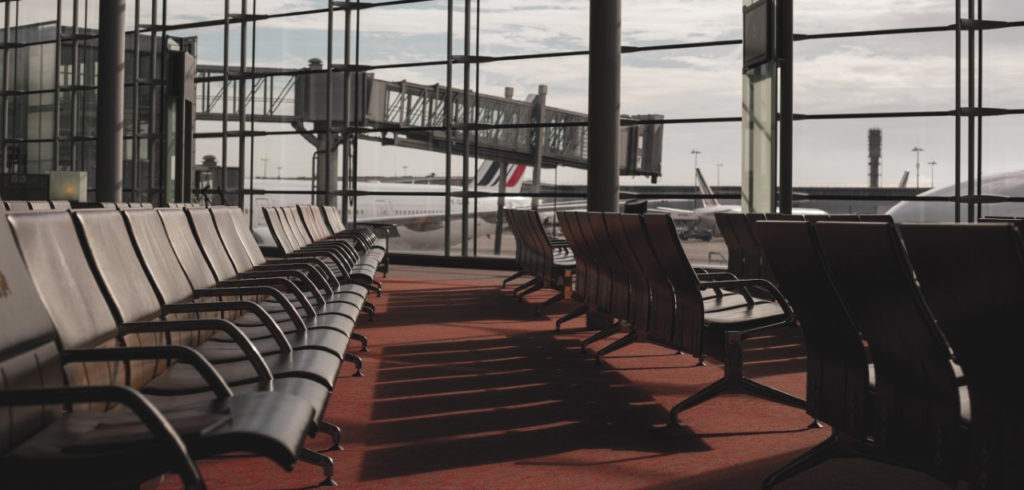It is often said that generals are always fighting the last war. When responding to Covid-19, airports cannot be guilty of the same failings, says Bryan Terry, managing director, Deloitte Global Aviation Leader
We all have orthodoxies—deeply held beliefs about how things are done that often go unstated and unquestioned. These orthodoxies can become standard practices that help individuals and institutions function more efficiently. But they may also lead to a dogmatic resistance to change and blind spots that can prevent us from developing new and better ways of working.
Sometimes critical events or external factors force a rapid examination of and challenge to existing orthodoxies. In the face of the Covid-19 pandemic, airports are forced to evaluate currently set approaches to airport passenger experience and adjust to these changing expectations in a way that allows them to thrive in the ‘new normal’.
Passenger processing technology was key. The future may be more about facility cleanliness
Prior to Covid-19, experience and passenger processing speed and efficiency were two critical factors in driving a passenger’s overall satisfaction. Because the perceived risk of spending time in an airport is higher than it has been since the immediate aftermath of the 2001 terror attacks1 , passengers are now watchful for signs of danger. These perceived risk factors require airports to think differently about how technology can be used to transform cleanliness as dramatically as it has for security and passenger processing.
In the near term, airports may pursue opportunities to leverage technology to help custodial services perform as efficiently and effectively as possible. For example, IoT-enabled fixtures and sensors at waste bins, sanitizer dispensers and other receptacles of personal hygiene consumables could drive restocking activities to prevent service failures.
In the longer-term, airports can engage passengers directly in the process through new technology. For example, the city of San Diego launched its Get It Done 311 app in 20182,,to allow citizens to report problems, request neighborhood repair and access services, all enabled by a CRM to manage and process cases2.
Passengers don’t just want self-service – they want it enabled by no-touch
Self-service was, and still is, the future. To personalize the traveler experience and improve speed and efficiency while reducing staffing requirements, self-service became a critical standard in the passenger journey.
But airport self-service technologies generally require a physical touch from passengers, creating new safety concerns in the Covid-19 era. Self-service won’t go away in the airport and passenger journey – it brings significant cost savings for airport stakeholders and improves processing efficiency. But it will likely quickly transition from self-service to no-touch, with the prevailing goal of reducing physical touchpoints across the passenger journey.
In the near-term, airports can increase cleaning protocols and rapidly deploy additional disinfecting wipes and hand sanitizer stations adjacent to any touchscreen services. In the medium- and long-term, airports can identify all touchscreen locations in the airport and select a dedicated solution to improve or replace the touchscreen services. New technology like self-cleaning screens can augment and enhance existing solutions to improve cleanliness, while assistive technology can turn current touchscreen devices into voice-activated and voice-facilitated capabilities.
Airports must instill confidence that current touchscreen solutions are clean and safe, while rapidly adjusting strategy and technology plans to accommodate the no-touch future.
Multi-model biometrics is the way of the future, and no-touch preferences will accelerate deployment
Over the last decade and half, advances in technology tailored for the airport environment, combined with decreasing costs, have led to interest in integrating biometrics into a variety of airport processes. Social distancing, masks and the current Covid-19 pandemic create a sense of urgency and a call for immediate action – quick remedies for contactless environments and technologies that secure and safeguard our travelers and airport employees and vendors. While Covid-19 demands new inquiry into contactless travel through airports, it also challenges the move toward capture of a single facial biometric as the solution.
What happens when you aren’t easily recognizable – when your face is obscured by a mask? While some new facial biometric technologies may address impediments posed by a mask, they may not be the only biometric option to create a seamless travel experience.
The future is multi-model and dependent on the ongoing evolution of biometric technologies. Each airport can take advantage of its own unique ecosystem as a testbed to explore touchless biometric options.
Airports can model every aspect of the airport environment for multi-model contactless biometric opportunities, and they can partner and leverage the capabilities of its in-house stakeholders. The key is adaptability to innovation and not a commitment to a single approach. New today is not new tomorrow, and airports must seek to tailor infrastructure to meet future needs and growth.
Employee health and safety will now define a positive employee experience
It comes as no surprise that a happier workforce provides better customer service. Organizations around the world have looked beyond employee engagement and considered the employee experience more broadly3. Since the Covid-19 emergency began, employee focus has shifted significantly from engagement to safety.
Front-line essential airport workers have close contact and continuous exposure to high-traffic public locations. This generates new concerns about access to personal protective equipment (PPE), health services and guidance on what to do if an incident occurs4. To fully engage at work, front-line employees want to be reassured that they will be safe, and that airport leadership is making their health and safety the top priority.
In the near-term, airport leadership can shift focus to implementing workplace safeguards and communicating often and proactively to reassure employees of their safety. Airports can also treat employee break rooms with the same care as they do passenger spaces.
In the medium- and long-term, proactive and regular communication of safety upgrades and other changes remain a priority. As frontline employees serve thousands of passengers, identifying the right technology, equipment and employee services for the Covid-19 world is critical.
 Airports no longer need to just keep up with passenger volumes. They need to plan for volumes to build back up, and right-size customer experience operations.
Airports no longer need to just keep up with passenger volumes. They need to plan for volumes to build back up, and right-size customer experience operations.
Airports of all sizes typically have a relatively consistent pattern of operations – albeit with daily and seasonal fluctuations – that are well anticipated. While local and regional anomalies are expertly managed by airport and airline planning teams and government regulators, the very uncertain nature of Covid-19 presents a significant forecasting challenge that needs greater analysis on an airport-by-airport basis.
Airport and airline forecasters are now planning in weeks rather than months, driving the need for increased collaboration and information sharing between airports, airlines and security agencies. This type of collaborative decision-making model is grounded in data sharing – and challenges many pre-Covid-19 norms for how aviation organizations generally share data among each other, outside of collaboration between a few select personnel.
Airports on their own cannot develop resumption plans that meet all the needs of their customers. They are highly dependent on their stakeholders to share information on opening status, flight volumes and specific passenger segment needs, and to implement technologies and processes that instill confidence in their customers.
This drives the need for enhanced collaboration around Covid-19 service resumption. This offers a unique opportunity for airports to enhance how they team and collaborate with their stakeholders.
Concluding thoughts – Airports can take immediate action to prepare for the Covid-19 world but must challenge traditional orthodoxies on customer expectations
The near-term and long-term future for airports will not be easy. And with passenger volumes at record lows and the future uncertain, operational and financial considerations are justifiably top of mind for airport operators. But the airports that achieve the most success coming out of the Covid-19 pandemic will likely be those that understand how their existing orthodoxies have been challenged.
Airports can start by analyzing impacts across the journey and engaging cross-airport stakeholders in resumption of service planning. These efforts can be phased and aligned to immediate airport and passenger needs. This plan guides the return of critical passenger capabilities and delivers the confidence passengers and employees need.
In the medium- and long-term, airports may consider re-evaluating strategic priorities and planned investments. Are these correct, and do these align with a Covid-19 world? Integrating robust forecasting, analytics and Voice of the Customer capabilities can enable ongoing analysis and input to make sure efforts are directly aligned with changes in passenger and employee behavior, and that they ramp back up appropriately.
The Covid-19 recovery will be challenging for airports, but accepting changes to existing orthodoxies can make the recovery easier. Sometimes it is easiest to start with a simple question:
What have we always accepted as truth that may no longer be the case in a Covid-19 world? The answer can be your guide to launch a successful recovery.
Additional authors for this piece were: Liz Krimmel, Jack Appelbaum, Dorian Reece, Patrick Salemme, Labdhi Seth, and Sue Ramanathan.


